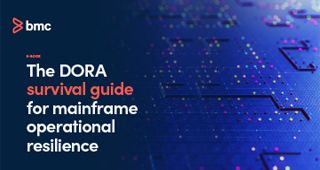In the bustling realm of finance, mainframe systems stand as silent sentinels, processing transactions and safeguarding sensitive data. Yet, in the face of escalating workloads and looming cyberthreats, traditional operational resilience measures may falter, exposing financial institutions and their data to risk. Enter the European Union’s Digital Operational Resilience Act (DORA), a transformative force reshaping the landscape of operational resilience in finance.
This act, with its comprehensive standards and framework, extends beyond distributed systems to include the mainframe as well, offering a lifeline of regulation and guidance to fortify critical infrastructures against the tides of uncertainty. Strengthening the core of mainframe systems not only ensures regulatory compliance but also bolsters their ability to withstand the dynamic pressures of the modern financial landscape. This article serves as a guide, exploring the essential components and technology considerations that empower financial institutions on their journey towards DORA compliance and, ultimately, resilience.
Reevaluating mainframe operational resilience in the digital age
Operational resilience has resurged as a top priority, reflecting the acknowledgment of its indispensable role in navigating the digital age. This resurgence is particularly pronounced when considering the mainframe systems that serve as the backbone of financial operations, managing vast amounts of sensitive data and transactions. In an era marked by escalating workloads and demands, as well as cyberthreats and potential disruptions, traditional operational approaches fall short, underscoring the necessity for a renewed focus on mainframe operational resilience.
The importance of operational resilience for mainframe systems is not merely theoretical—it’s a strategic imperative for financial institutions. Every transaction, data point, and critical operation relies on the mainframe, making any disruption a significant risk. The repercussions of not embracing new technologies to enhance resilience are multifold—financial organizations risk not only regulatory non-compliance but also jeopardize the integrity of their operations.
Increased mainframe workloads demand a paradigm shift, and without a robust operational resilience framework powered by innovative technologies, institutions risk compromising the very core of their mainframe operations, putting data security and operational stability at stake. Embracing new technologies isn’t just a choice; it’s a necessity for financial organizations aspiring to thrive and remain resilient in the face of the evolving digital landscape.
Embracing DORA: Beyond compliance to mainframe operational resilience
DORA introduces a pivotal shift in the financial sector, expanding beyond traditional compliance into a comprehensive framework that reimagines service awareness, risk management, business continuity, and governance. This evolution in regulation serves as a call to action for financial institutions, urging them to proactively enhance their mainframe infrastructure.
As DORA harmonizes risk management practices and raises the standard for resilience in mainframe systems, it emphasizes not just compliance but a transformation of mainframe operations to meet the challenges of a dynamic digital landscape. This necessitates embracing advanced mainframe technology solutions, crucial for maintaining robustness and agility in response to these evolving demands.
DORA sets a regulatory focus on five key topics impacting mainframe operational resilience
DORA emphasizes the importance of holistic operational resilience principles, urging financial institutions to gain a thorough comprehension of their entire IT infrastructure, discern potential vulnerabilities and risks, and establish resilient automated strategies to safeguard their systems, data, and clientele from cyberthreats and other potential disruptions. Key areas of DORA focus include information and communication technology (ICT) risk management, incident reporting, resilience testing, ICT third-party risk management, and information sharing. Nevertheless, companies utilizing mainframe systems should consider the following:
1. Service awareness and availability
Effective technology for service awareness includes regular health checks, automated maintenance, and predictive alarms based on workload patterns. Log mechanisms aligned with DORA’s transparency requirements offer real-time insights into mainframe activities.
2. Risk management
Beyond standard vulnerability assessments, technology solutions for risk management involve real-time monitoring tools, security patch updates, and dynamic risk mitigation. This approach addresses exposures and vulnerabilities, aligning seamlessly with DORA standards.
3. Business continuity management
Technological considerations for business continuity management include comprehensive recovery plans, failover mechanisms, and automated backup solutions. Integration of cloud storage ensures scalability, meeting DORA expectations for enhanced recovery objectives.
4. Incident management
An effective incident management approach involves the seamless integration of monitoring alerts into an enterprise service console. Automated response playbooks and collaborative incident resolution align with DORA guidelines for efficient incident management.
5. Governance and compliance
Technology for governance and compliance encompasses vulnerability scanning tools specific to mainframe environments. Automated compliance checks, regular audits, and the evolution of governance processes ensure adherence to DORA components.
Operational resilience toolchain: a holistic approach
In navigating the intricacies of DORA compliance, the focus should extend beyond specific solutions to a holistic toolchain approach. Technologies that empower financial institutions share common attributes:
1. Identify
Early detection mechanisms and robust data analysis capabilities are integral. Technologies that offer insights into potential issues and risks provide a proactive foundation for resilience.
2. Protect
Implementation of security measures and safeguards for mainframe systems is crucial. Technologies that fortify defenses, ensuring the integrity of critical data, contribute to DORA-aligned protection.
3. Detect
Real-time monitoring tools equipped with anomaly detection capabilities are essential. Technologies that vigilantly spot threats in vast data landscapes align with DORA’s emphasis on understanding potential impacts.
4. Respond
Incident response protocols and collaborative incident resolution mechanisms are vital. Technologies that facilitate well-defined action plans and coordinated efforts to limit the impact of cybersecurity events meet DORA guidelines effectively.
5. Recover
Swift recovery strategies and post-incident analysis capabilities are key components. Technologies that streamline recovery processes and offer insights for continuous improvements contribute to a resilient mainframe environment.
Summary: A technological compass for mainframe resilience
As financial institutions embark on the journey towards DORA compliance and the intricacies of mainframe operational resilience, this exploration serves as a technological compass, guiding financial institutions towards a fortified future. We’ve underscored the imperative of adopting innovative technologies that align with the key components of DORA. From service awareness to governance and compliance, the compass points towards solutions that offer early detection, robust safeguards, real-time monitoring, efficient incident response, and swift recovery strategies. The essence lies not just in compliance but also in leveraging technology to proactively fortify mainframe systems, ensuring they both meet regulatory standards and stand resilient against the ever-evolving challenges of the digital landscape.
Want more resources to learn about DORA and it’s impact on mainframe operational resilience? Go to BMC’s DORA Survival Guide and learn how to fortify your mainframe.





